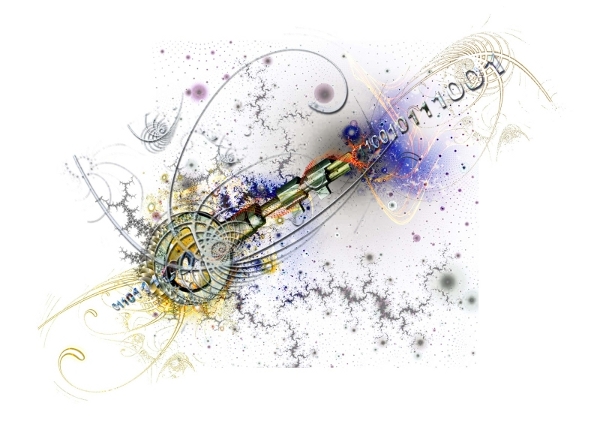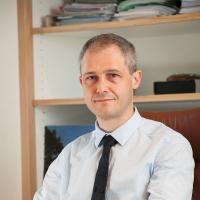Nonlinear Delay Dynamics &
Advanced Photonic Applications
Chaos for optical secure communications / Limit cycle for high spectral purity microwave Radar sources / Nonlinear Transients from stable steady states, for Photonic Neuromorphic Computing

Nice graphics illustrating all together nonlinear dynamics, binary digits cryptography, and information processing
(Credit: Muriel Jacquot 2004, original idea LL).
My early interest in nonlinear dynamics mainly started with my PhD ("Wavelength chaos for optical encryption", 94-97, adviser Prof. Jean-Pierre Goedgebuer). Since then, I never stopped enjoying doing research in that area. More precisely, my research is developed in the particular framework of advanced photonic applications involving the many different dynamical behavior performed by nonlinear delay optoelectronic feedback loop systems. These behavior span from high complexity chaotic motions (typ. used for chaotic optical encryption, or ultra-fast random number generation), to complex transients excited from a stable steady state (photonic computing via Liquid State Machines / Echo State Network / Reservoir Computing principles), through high regularity limit cycles (e.g. for pure tone radar microwave sources).
This research is developed within the Optoelectronics, Photonics and Optical Telecommunications (OPTO) Group in the Optics department P.M. Duffieux of the FEMTO-ST Institute. FEMTO-ST is a research institute affiliated to the French National Center for Scientific Research (CNRS, allowing for full researcher positions to the institute), and having seven disciplinary departments (automatic and control theory, computer science, energy, mechanical engineering, micro and nano sciences and systems, photonics, time and frequency metrology). Half teaching and half research staff are employed by three different universities and engineering schools (University of Franche-Comté -my affiliation-, ENSMM and UTBM).
Since 2015, the academic space is being reorganized within the creation of the university Bourgogne Franche-Comté (UBFC), the new federal space for higher education and research in the recently merged Region Bourgogne Franche-Comté
The main scientific achievements can be summarized as follows: first demonstration of optical chaos communications (patented in 1996, Phys. Rev. Lett. 1998) using a chaos in wavelength approach; design, demonstration, and theoretical description of a chaotic oscillator involving coherence modulation (JOSA B 2001); (one of the?) first introduction of bandpass (integro-differential) delay dynamics (IEEE Trans. Circ. Syst.. 2002, Phys. Rev. Lett. 2005, Phys. Rev. E 2009, Nature News & Views 2010); fastest (3Gb/s) and highest link quality (10-9 bit error rate) in a laboratory optical chaos communication link (Electron. Lett. 2004) with an intensity electro-optic (EO) chaos generator; with that same setup, main contribution to the first field experiment on optical chaos communication over more than 100km of the metropolitan area network of Athens (Nature 2005); first experimental demonstration of distant isochronous chaos synchronization in mutually coupled delay EO oscillators (Phys. Rev. E 2007) experimental and theoretical description of the envelope modulation instability occuring in microwave oscillations from a delay line narrowband optoelectronic oscillators (Opt. Lett. 2007); demonstration of a microwave photonic oscillator involving an MgF2 5-millimeter diameter optical disk resonator (IEEE Photon. Technol. Lett. 2010); fastest (10Gb/s) and highest link quality optical chaos communication (IEEE J. Quant. Electron. 2010) using EO phase chaos architecture and first field experiment at that speed on the "Lumière brothers" fiber ring network in our city of Besançon, France; hybrid analog and digital key optical chaos communication (Phys. Rev. Lett. 2011) first experimental demonstration of a photonic liquid state machine performing a physical neuromorphic computer (Opt. Expr. 2012; Phys. Rev. Lett. 2012; Neural Net. 2013; Sci. Rep. 2015). While addressing delay dynamics-based photonic neuromorphic computing, we also studied from a fundamental viewpoint the intrinsic dynamical complexity exhibited by integro-differential delay dynamics; this led us to the discovery of two surprising features of this particular class of infinite dimensional temporal dynamics: a stable single delay periodic solution (Phys. Rev. E 2012) which was believed to be always unstable, as well as the existence of Chimera states (Phys. Rev. Lett. 2013; Nat. Commun. 2015) which have been explored recently, and only for spatio-temporal dynamics made of a network of non locally coupled oscillators.
Together with a strongly growing involvement in the management of the FEMTO-ST research institute, a few but very nice (at least for me) results have been obtained. From a more science dissemination perspective but also from a few very interesting and highly original scientific sides, a live demonstrator was designed about chaotic color generation in the visible spectrum. This chaotic rainbow generator was published in Phys. Rev. A (2016).
As a confirmation of the relevant potential of Optical Telecom technologies for Photonic Reservoir Computing, a world record in speech recognition speed was published in Phys. Rev. X(2017), which result was selected for a Physics Viewpoint, as well as for a Research Highlight in Nature.

